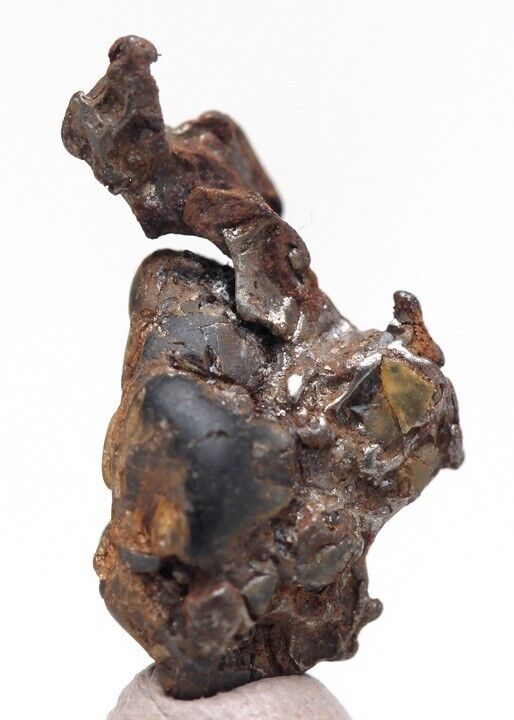 On eBay Now...
On eBay Now...RARE Admire Iron Meteorite Specimen Pallasite Skeleton Olivine Meteor KANSAS For Sale

When you click on links to various merchants on this site and make a purchase, this can result in this site earning a commission. Affiliate programs and affiliations include, but are not limited to, the eBay Partner Network.
RARE Admire Iron Meteorite Specimen Pallasite Skeleton Olivine Meteor KANSAS:
$34.99
This specimen weighs 1.94 grams. It measures 18 mm x 10 mm x 7 mm.I offer a shipping discount for customers who combine their payments for multiple purchases into one payment!The discount is regular shipping price for the first item and just 50 cents for each additional item!
To be sure you get your shipping discount just make sure all the items you want to purchase are in your cart.
sales you win are added to your cart automatically.
For any "buy it now" items or second chance offers, be sure to click the "add to cart" button, NOT the "buy it now" button.
Once all of your items are in your cart just pay for them from your cart and the combined shipping discount should be applied automatically.I offer a money back guarantee on every item I sell.
If you are not 100% happy with your purchase just send me a message to let me know
and I will buy back the item for your full purchase price.Hi there, I am selling this Amazing Admire Pallasite Meteorite! Pallasites are filled with olivine crystals. This meteorite fell in Kansas. I know it would make an AMAZING addition to any collection of ANY type, but especially of meteorites and stones! Don't let this one pass you by. If you have any questions, do not hesitate to ask me. Have fun offerding, thanks so much for visiting my sale and have a great day!If you purchase from me you should know that the authenticity of this meteorite is guaranteed!
Iam a member of the IMCA or the International Meteorite Collector'sAssociation. This is an organization that is a check and balance ofthose who collect, trade and sell meteorites. You can only join thisorganization by having the utmost integrity. You must to have two references from existing members to get in and a goodreputation. Members of this organization maintain a highstandard by monitoring each others' activities for accuracy and honesty. It isevery IMCA member's responsibility and pleasure to offer help andassistance to fellow members in order to ensure specimens are genuine. It is not wise to purchase meteorites on or other sources from those who are not IMCA members. This is a verytight-knit community made up of meteorite hunters, dealers, collectors, and scientists who look out for each other to make surethat the meteorites offered to the public are authentic and genuine. I encourage you to visit the IMCA website and getmore information on what being a member means, and how your purchasesfrom its members are guaranteed.
IMCA Member #7446
Below is some information about this meteorite:
Pallasite
From Wikipedia, the free encyclopediaPallasites— Class —
The pallasites are a class of stony–iron meteorite. They are relatively rare, and can be distinguished by the presence of large olivine crystal inclusions in the ferro-nickel matrix.
These crystals represent mantle and core material from differentiated planetesimals, which were destroyed by violent collisions during the early formation of the Solar System.
Structure and compositionIt consists of centimetre-sized olivine crystals of peridot quality in an iron-nickel matrix. Coarser metal areas develop Widmanstätten patterns upon etching. Minor constituents are schreibersite, troilite, chromite, pyroxenes, and phosphates (whitlockite, stanfieldite, farringtonite, and merrillite).[1][2]
Classification and subgroups
Main group pallasites (PMG): Almost all pallasitesEagle Station group (PES): 5 specimens known. They are related to IIF irons.Pyroxene Pallasite grouplet (PPX): Counts only Vermillion and Yamato 8451. They take their name from the high orthopyroxene content (about 5%). Metal matrix shows a fine octahedrite Widmanstätten pattern.Pallasite ungrouped (P-ung): Specimens that don't fit into any groups or groupletsOriginPallasites were once thought to originate at the core-mantle boundary of differentiated asteroids that were subsequently shattered through impacts. An alternative recent hypothesis is that they are impact-generated mixtures of core and mantle materials. This hypothesis is supported by isotopic analysis indicating admixture of material from multiple planetesimals.[5] [6]
History
Krasnojarsk meteoriteA common error is to associate their name with the asteroid 2 Pallas but their actual name is after the German naturalist Peter Pallas (1741–1811), who studied in 1772 a specimen found earlier near Krasnoyarsk in the mountains of Siberia that had a mass of 680 kilograms (1,500 lb).[a] The Krasnoyarsk mass described by Pallas in 1776 was one of the examples used by E.F.F. Chladni in the 1790s to demonstrate the reality of meteorite falls on the Earth, which most scientists at his time considered as fairytales. This rock mass was dissimilar to all rocks or ores found in this area (and the large piece could not have been accidentally transported to the find site), but its content of native metal was similar to other finds known from completely different areas.[7][8]
Pallasite fallsPallasites are a rare type of meteorite. Only 61 are known to date, including 10 from Antarctica, with four being observed falls.[9][10] The following four falls are in chronological order:
Mineo, Sicily, Italy. A luminous meteor was observed and an object seen to fall with a loud roar in May 1826. Only 46 grams (1.6 oz) are preserved in collections.Zaisho, Japan. 330 g were found on February 1, 1898,[11] after the appearance of a fireball.Marjalahti, Karelia, Russia. After the appearance of a bright meteor and detonations, a large mass was seen to fall and 45 kilograms (99 lb) were recovered in June 1902. At this date the fall site belonged to Finland, and the main mass of Marjalahti is now at the Geological Museum of the University of Helsinki.Omolon, Magadan Region, Russia. A reindeer-breeder observed the fall on May 16, 1981, and found the 250 kilograms (550 lb) meteorite two years later. The fall was confirmed by a meteorological station that had observed a fireball on the same date.Notable pallasite finds
Brenham
Imilac full sliceAlthough pallasites are a rare meteorite type, enough pallasite material is found in museums and meteorite collections and is available for research. This is due to several large finds, some of which yielded more than a metric ton. The following are the largest finds:
Brenham, Kansas, United States. In 1890 the find of about 20 masses with a total weight of 1,000 kilograms (2,200 lb) around the shallow Haviland Crater were reported. More masses were found later, including one of 454 kilograms (1,001 lb) from a depth of 5 feet (1.5 m), the total amounting to about 4.3 tonnes (4.2 long tons; 4.7 short tons). A piece of 487 kilograms (1,074 lb) is in the Field Museum of Natural History, Chicago. In 2005, Steve Arnold of Arkansas, USA, and Phil Mani of Texas, USA, unearthed a large mass of 650 kilograms (1,430 lb) and in 2006 several new large masses [12][13] Don Stimpson and Sheila Knepper have found approximately 8,000 lbs. of the Brenham meteorite on their farm property.[14]Huckitta, Northern Territory, Australia. A mass of 1,400 kilograms (3,100 lb) was found in 1937 on a cattle station north-east of Alice Springs. Earlier, in 1924, a transported piece of about 1 kilogram (2.2 lb) had been found on Burt Plain north of Alice Springs.Fukang, Xinjiang Province, China. A mass of 1,003 kilograms (2,211 lb) was recovered in 2000.Imilac, Atacama Desert, Chile; known since 1822. Numerous masses up to 200 kilograms (440 lb) were found, the total weight is about 920 kg.Brahin, Gomel Region, Belarus, known since 1810. Many masses were found strewn in a field, with a total weight of about 820 kg. An additional mass of 227 kg was found at a depth of 10 feet (3.0 m) in 2002.Esquel, Chubut, Argentina. A large mass of 755 kg was found embedded in soil before 1951.Pallasovka, Pallasovka, Russia. A single mass of 198 kg was found near Pallasovka, Russia in 1990. Coincidentally, both the town of Pallasovka and pallasite meteorites were named after the naturalist, Peter Pallas.Krasnojarsk, Yeniseisk, Russia. A mass of about 700 kg was detected in 1749 about 145 miles (233 km) south of Krasnojarsk.[15] It was seen by P. S. Pallas in 1772 and transported to Krasnojarsk (see above). The main mass of 515 kg is now in Moscow at the Academy of Sciences. Pallasites are named after Peter Pallas for his study of this meteorite.Seymchan, discovered near the town by the same name, in far eastern Russia in 1967. This main group Pallasite has some areas free of olivine crystals, and may have formed near the junction of the core and the mantle of an asteroid. Multiple masses in excess of 1 tonne have been recovered. Related Items:
RARE Admire Iron Meteorite Specimen Pallasite Skeleton Meteor KANSAS
$39.99
1989 Collegiste Collection Coka-Cola Micheal Jordan # 18 AWESOME CARD
$325.00
President Jimmy Carter Signed Cut Autographed PSA DNA Full Signature RARE
$299.99








